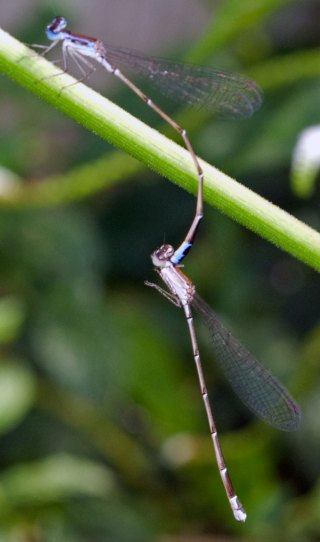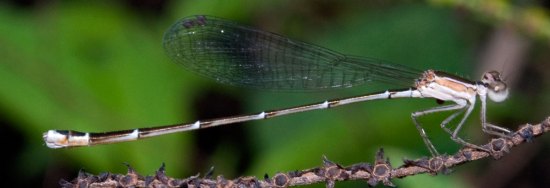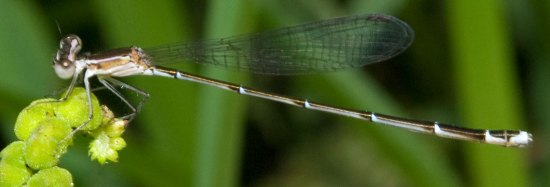Damselfly behavior notes: Everglades Sprites in tandem
Part of the fun of documenting the presence and behavior of the animal and plant species in your back yard is the opportunity to contribute, in however slight a way, to an improved understanding of our world. My “study site,” which is my 1/4-acre property in downtown (but basically suburban) Boca Raton, is small enough that most of the animals come and go, and while I welcome those that come, I can’t follow them when they go.
That means that for most of the organisms I write about on this blog, I take a few snapshots, do a little book research (often in 18th- and 19th-century taxonomic catalogues that are now available online thanks to Google Books), and that’s about it. I wave goodbye to the species and hope to encounter it again someday.
But I’ve always wanted a richer, deeper encounter, one where I can see how this animal actually behaves. A couple of weeks ago, I got a taste of this kind of observation, when I was lucky enough to observe a pair of Rambur’s Forktail damselflies (Ischnura ramburii) copulating on one of my young Bitterbush plants.
This week I got another, more prolonged encounter with another species, Nehalennia pallidula, aka the Everglades Sprite. I happened to observe a pair in tandem as I was doing my daily perimeter patrol with camera. This is a species for which as recently as 1990 the mating behavior was completely unknown (Dunkle 1990). Since that time, more has been discovered, enough so that Paulson (2011) is able to write about the timing of sightings of mating pairs, but it’s still kind of fun to be able to add to the behavior accounts of a little-known animal.
It’s been decades since I wrote a biology report, but I was inspired by this event to try my hand at it; I apologize for the rather dry nature of the rest of this post, but it was a lot of fun for me to write. And I stuck in a lot of pictures, so I hope that’ll make it interesting enough for y’all!
Date: Tuesday, May 15, 2012.
Time: 9:45–11:05 a.m. EDT.
Weather: Partly cloudy, intermittent light rain in area. 81°F, 30.02 mm Hg at start, 83°F, 30.03 mm Hg at finish.
Site information: Small suburban backyard in Boca Raton, FL (26.35691°, -80.09095°) with water present (not a viable oviposition site, as it is a well-maintained swimming pool, although there may be standing pools of water in neighboring properties). Vegetation includes numerous herbaceous forbs, grasses, vines, and woody plants approximately 1.5 m south of a wooden 1.6-m tall privacy fence, and 2 m north of a 1.25-m tall mesh pool safety fence. The ground slopes down approximately .75 m between the two fences, which are separated by about 3.5 m. Five zygopteran species have been recorded on the site: three forktails (Ischnura ramburii, I. hastata, and I. posita), a bluet (Enallagma sp., likely doubledayi), and a sprite (Nehalennia pallidula).
Observations
During the past two weeks the site has been visited by several zygopteran species, including at least 4 individuals of Nehalennia pallidula. Rain has become more frequent and intense in the past four days, and today, during my daily inspection of the property, at 9:45 a.m. EDT I observed a pair of Nehalennia pallidula (Calvert, 1913) perched in tandem on the inflorescence of a 1 m2 Heliotropium angiospermum; small runners of the vine Passiflora incarnata were growing intertwined with the plant as well.
The damselfly pair was motionless for some time, but took flight as I approached closer (approx. 0.5 m). The pair flew to a different perch nearby, this time on a nearly vertical, and fairly slender, stem of P. incarnata.
They remained there for some time (I estimate >10 min, but I did not have a watch with me, so was relying on the time stamp of my digital camera), during which time the male flexed the tip of his abdomen rhythmically about once every second, thereby swinging the female, presumably in an attempt to bring her into the copulatory position (Stage D of Corbet’s diagram). In this image you can see that the male’s tail tip is strongly flexed, and the female’s tail tip is blurred by the motion, but her abdomen is straight:
The swinging was relatively rhythmic, approximately once per second for approximately one minute, followed by a shorter (<30 seconds) rest period, after which the male resumed flexing the abdomen. This flex–rest cycle happened five times, throughout which (and indeed throughout the encounter) the female remained with abdomen rigid and legs tucked under the thorax.
At one point the female fluttered her wings, but the male was not induced either to release her or to move to a new perch. The male’s wings were observed to be held slightly spread, rather than folded together over the back as in the normal (horizontal) perching position. Presumably this allows greater stability to support the weight of the female while perched in tandem. The female’s legs are folded up tight to the thorax, presumably to minimize drag in case the male needs to move the perch.
After about 10–15 min, a lizard moved close to the pair, after which the pair changed perches 3 to 4 times in less than a minute before settling back on another stem of Passiflora incarnata; this one quite a bit thicker than the first:
They remained on this perch for some 3 minutes (until 10:02), after which I lost track of the pair and assumed they had left the area.
I later (10:10) discovered that a single male Ischnura posita had come to occupy the part of the plant that the pair had briefly visited before disappearing:
I assumed that the arrival of this individual had prompted the departure and perhaps even separation of the N. pallidula pair, as I later (10:36) noticed a lone female N. pallidula near the original site of contact. This female, however, seems to have been a different individual—the amount of black on abdominal segments 9 and 10 appears greater, and I am fairly sure that the female in the tandem pair did not have a mite on her thorax, while this lone one did (although the legs of the female in tandem were folded under the thorax, which prevented me from observing the presence or absence of mites):
At 10:38 I found the tandem pair again and was able to observe them for another few minutes before I lost track of them again (at 10:42). I assume that they separated afterwards, because at 11:04 a.m., I observed a lone N. pallidula who closely resembled the female of the pair (at least, this individual’s tail markings were very similar, and she did not have a mite on her thorax).
Discussion
In 1990, Dunkle wrote that the biology of this species was unknown; Paulson, writing in 2011, was able to give some details about when mating pairs are seen (only after the rainy season has begun). While it’s not clear that this pair did mate, it is evident, based on these observations, that tandem flight in N. pallidula lasts at least one hour, probably more. I did not observe copulation, although I was unable to determine whether it was because the female was immature or unwilling, or whether it did occur but during the time I was unable to observe the pair.
Etymology
As usual, I like to provide the etymology whenever I can. Nehalennia is a river goddess depicted on numerous votive altars from the area where the Rhine river flows into the North Sea. The English name for the genus is Sprites; according to Paulson and Dunkle’s checklist, this name comes from the fact that “species are tiny and difficult to detect.” The scientific name, pallidula, means “little pale,” which, again according to Dunkle, refers to the “greater extent of pale color on sides of thorax than other Nehalennia.”
References
Dunkle, S.W. (1990). Damselflies of Florida, Bermuda, and the Bahamas. Gainesville, FL: Scientific Publishers.
Paulson, D.R. (2011). Dragonflies and Damselflies of the East. Princeton, NJ: Princeton UP.
Paulson, D.R. and Dunkle, S.W. (2012). A Checklist of North American Odonata. including English Name, Etymology, Type Locality, and Distribution. Available online.








